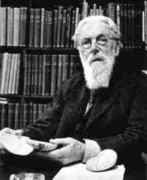◀ ▲ ▶History / 19th-century / Person: Thompson, D'Arcy
Person: Thompson, D'Arcy

D'Arcy Thompson was a Greek scholar, a naturalist and a mathematician. He was the first biomathematician. His book On Growth and Form had a great influence on both biologists and mathematicians.
Mathematical Profile (Excerpt):
- D'Arcy Thompson senior was appointed Professor of Greek at Queen's College, Galway (now part of the University of Ireland) when D'Arcy was 3 years old.
- In 1880 Thompson was a sizar, meaning that he obtained financial support by acting as a servant to the older boys, then in 1881 he was awarded a scholarship.
- There was a group of young Cambridge men who were lying the foundations of the science of biology at this time and Thompson quickly became part of the group.
- In 1884 D'Arcy Thompson was appointed Professor of Biology in Dundee (incorporated as part of the University of St Andrews in 1897) and later the title of his chair was changed to natural history.
- In 1917 D'Arcy Thompson was appointed to the Chair of Natural History in St Andrews.
- D'Arcy combined skills in a way that made him unique.
- Although he was to write around 300 scientific articles and books all D'Arcy's various skills came together in his most famous book On Growth and Form (1917).
- D'Arcy related such things to the Greek work on approximating π, √2 and Euclid's Elements.
- He fishes were of great interest to Thompson who was highly involved with the international organisation and regulation of fisheries as we mentioned above.
- D'Arcy Thompson was elected a Fellow of the Royal Society of London in 1916 and was vice-president of the Society in 1931-33.
Born 2 May 1860, Edinburgh, Scotland. Died 21 June 1948, St Andrews, Fife, Scotland.
View full biography at MacTutor
Tags relevant for this person:
Applied Maths, Origin Scotland
Thank you to the contributors under CC BY-SA 4.0! 

- Github:
-

- non-Github:
- @J-J-O'Connor
- @E-F-Robertson
References
Adapted from other CC BY-SA 4.0 Sources:
- O’Connor, John J; Robertson, Edmund F: MacTutor History of Mathematics Archive
